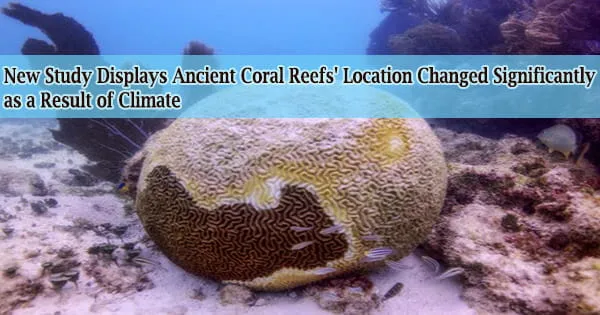The research, which was published in Nature Communications, shows how variations in temperature and plate tectonics during a time when the placements of Earth’s continents were considerably different from what they are now have influenced the spread of corals over geological time.
Although the location of coral reefs has frequently been attributed to climate, this has not yet been demonstrated due to the scarcity of fossil records. For the first time, a group of worldwide scientists have combined climate reconstructions and habitat modeling to foretell the distribution of coral reef-friendly settings throughout the past 250 million years.
The researchers from the Universities of Vigo in Spain, the University of Bristol, and University College London in the UK then used warm-water coral reef fossils to verify their predictions.
They demonstrated that due to warmer climate conditions and a more uniform distribution of shallow ocean floor, corals existed far farther from the equator 250 to 35 million years ago than they do today.
“Our work demonstrates that warm-water coral reefs track tropical-to-subtropical climatic conditions over geological timescales. In warmer intervals, coral reefs expanded poleward. However, in colder intervals, they became constrained to tropical and subtropical latitudes,” said first author Dr. Lewis Jones, a computational palaeobiologist research fellow at the University of Vigo.
Since around 35 million years ago, only tropical locations have been able to sustain suitable coral habitats due to global cooling and an increase in shallow oceans brought on by tectonic shifts in the Indo-Australian Archipelago, which is known as a hotspot for marine biodiversity.
According to the researchers, coral reef ecosystems are unlikely to match the rapid rate of human-induced climate change, despite the fact that this shows warm temperatures in the past allowed for long-term poleward coral expansions.
Climate has changed significantly throughout geological time, however understanding how it has impacted coral reef ecosystems has been difficult due to a lack of quantifiable data which has significant gaps. Using this new combined data-model approach we can start to better understand reef ecosystems’ evolution and behavior.
Dr. Alex Farnsworth
“Current anthropogenic climate change will result in the poleward expansion of suitable habitat for coral reefs. In fact, we are already witnessing the expansion of some tropical reef corals. However, whether coral reef ecosystems and all the biodiversity they support can keep pace with the current rapid rate of anthropogenic climate change is another question,” Jones said.
“Limiting global warming is fundamental to saving coral reefs, as well as the biodiversity they house. Yet, perhaps even more important is reducing the rate of global warming.”
The largest diversity of marine animals on Earth are supported by warm-water coral reefs, commonly referred to as “rainforests of the sea.” These biologically diverse habitats, which include reef fishes, are only found in the tropics and subtropics of today’s oceans, when water temperatures rarely drop below 18 oC.
The Indo-Australian Archipelago is home to a sizable fraction of its contemporary biodiversity. Coral reef ecosystems did, however, once exist outside of the tropics and subtropics, as evidenced by the discovery of fossils far farther from the equator.
Co-author Dr. Alex Farnsworth, Senior Research Associate in meteorology and climate modelling from the University of Bristol Cabot Institute for the Environment, said:
“Climate has changed significantly throughout geological time, however understanding how it has impacted coral reef ecosystems has been difficult due to a lack of quantifiable data which has significant gaps. Using this new combined data-model approach we can start to better understand reef ecosystems’ evolution and behavior.”
Due to the inadequate and biased fossil record, previous research has been unable to establish a robust correlation between temperature and the distribution of coral reefs.
For instance, not all the fossilized remains of ancient organisms or ecosystems are preserved, and it has been demonstrated that GDP is the most significant factor in explaining the distribution of ancient reefs in samples, with the majority of the data on fossil reefs coming from wealthy nations simply because this is where we have concentrated our efforts.
Co-author Dan Lunt, Professor of Climate Science at the University of Bristol Cabot Institute for the Environment, added:
“This work highlights that climate and ecosystems have been intimately entwined together in Earth’s past history. This has crucial implications for ecosystems today, given current global warming.”





